
In November 2014, almost 200 marketers, data analysts, agencies and vendors gathered at the Cypress Lakes Resort in the Hunter Valley for the second annual Data Strategy Symposium run by Ashton Media.
Today’s post is the final of three adapted from the presentation given by international keynote speaker Travis Wright, Marketing Technology Entrepreneur, Data & Analytics Geek, Media Think Labs (US).
Click on the relevant link to read Part 1 or Part 2.
Figuring out personalisation and attribution

Personalisation – people talk about B2B and B2C. Bryan Kramer wrote a great book called “H2H, Human to Human” and I think that’s really what it is. That’s not B2B, we’re all people at the other end.
Most websites are really good at the masses and advertising to everybody, kind of like AT&T is doing, but they’re largely irrelevant to that individual user so we want to get more personalised. How we can do that is through personalisation and attribution, trying to figure this out.
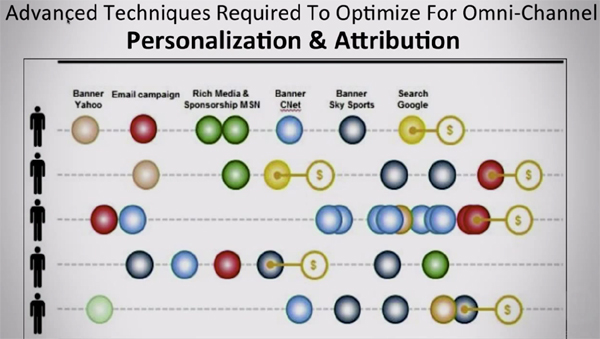
We’ve heard about the last click attribution – where the last click comes from. “So look, they searched Google and they bought something. It must have been Google that did it.” Well, maybe not, but look at all these other places, they saw a banner on Yahoo, maybe they read a white paper, they saw a couple of blog posts, they saw an ad on ‘Seen Ad’ or a banner on ‘Sky Sports’, or ‘ESPN’. There’s the path to conversion.
If you’re trying to attribute that and you’re saying, “Well, where do I put my money for my advertising? Which one’s working?” That’s where attribution comes in. Maybe some of those are more important than others and you want to put more money in different buckets because some of those maybe didn’t work at all, but some of them did. It’s a matter of figuring that stuff out, figuring out what is triggering that customer and those customers to buy from you. Understanding that is huge.
Here’s another stat that just blows me away. US retailers lose a hundred billion dollars a year on poorly executed cross-channel marketing. I’m sure that’s the same all across the world. There’s these different numbers but it’s insane to me that so much money is being wasted, and so it’s my responsibility. I’m taking it on to help people stop wasting so much money. We’ve got to be smarter. I’m like a politician right now, “Stop wasting money. We’re going to do it.”

Agility is important
All of these really wrap around being agile and flexible and being able to move quickly in the space. Agile is nimble, limber, acrobatic, fleet-footed, light-footed, just like this guy. Even the big guys can be agile. Watch this dude. This is crazy. Big dude, oh yeah. Three, four, five, oh yeah, six flips. That’s amazing. I’m inspired. I’m going to do a flip right now. I’m not going to do that. I don’t want to hurt myself. That would be ridiculous.
Here’s the example of not being agile. This guy, screw it. I’m just going to ride it up. That’s cool. I like it, so he’s like “All right. Well, wait, do I have my lunch? Yeah, I got my lunch.” I want to see the end of this one though, does he pinch his ass at the end or does he get up halfway up? Because that would be really extra hilarious if he pinched his ass.
All right, a summary here real quick
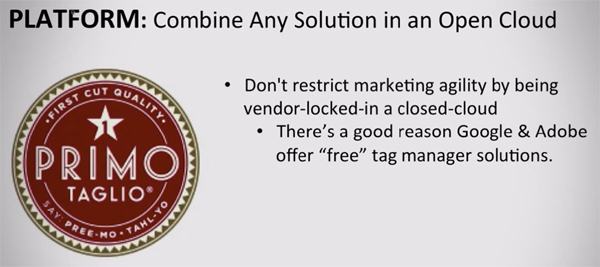
What we want to do is combine any solution and build our own open cloud. We don’t want to restrict marketing agility by being vendor-locked into a closed cloud.
There’s a reason why Google and Adobe offer free tag management systems, it’s to get you locked into their ecosystem. Again, very hard to unwind that down the road when they own all your data and they’re tapped in with all those tools. Sometimes, they’re not going to let some of those tools in. It’s really important to have an independent buffer in between that so you can use all those tools.
A single closed-cloud can solve all your marketing problems, plus there’s innovations popping up all over the place. Unlock all those options that are going to fit your business, take advantage of the best in breed.
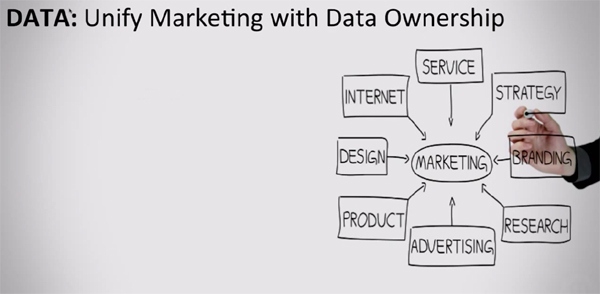
You want to assemble your own data layer to unify and enrich your marketing solutions. You want to ensure that your data is quality and you want to be able to pass that to all your vendors, standardise that with the profiles, and you want to know your customer’s journey. You want to establish a 360 degree view of them across all the channels and be able to market to them effectively. Knowing your customer is huge.
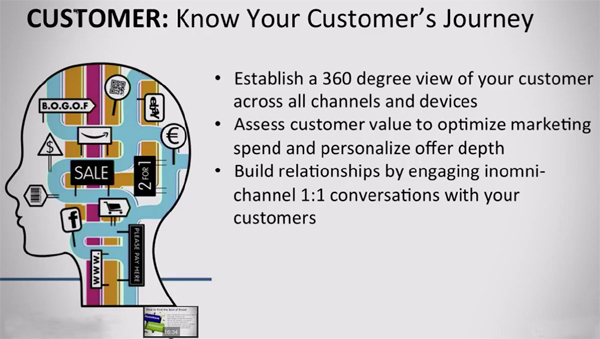
We want to feel known, like me walking up and them [Optus] knowing who I was, “Hey, Travis.” I was like “What?” That’s great, so you want your customers to feel that and build that one-to-one relationship with them. Business Relationship Optimisation, right?
We want to do it real time, right now; manage it, real time, intelligent action. Being able to make different marketing decisions across different channels and different solutions is going to really improve your ROI. It’s going to allow you to create a better deal or a better offer for your customers when they come to your site. It’s important.
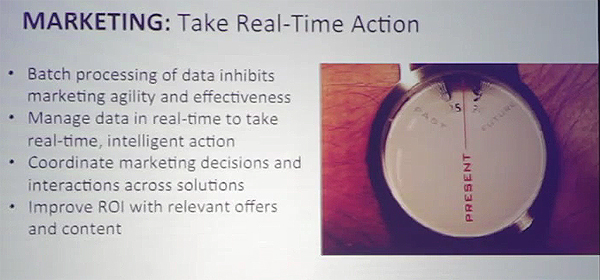
Again, another amazing gift, this is so exciting. They’re really excited about data management. I love it, in reverse too when he puts his glasses back on, he’s all out, ‘Deal With It’. This is great.

Different marketing technologies
So, we talked about all of these technologies here. If you’re in social media or you’re in marketing, maybe these are some of the ones that are relevant for you. Not all of them are going to necessarily be relevant for everyone, it depends, some of them are going to be more relevant than others.
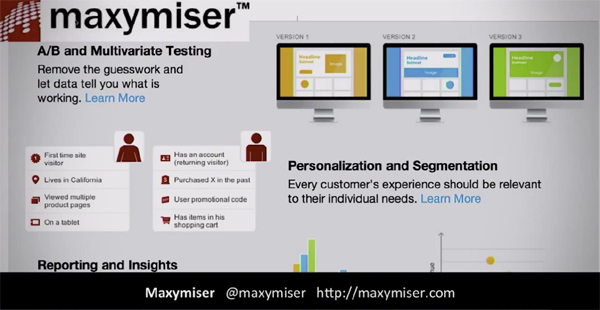
Here’s a really cool tool if you guys are trying to do some AB testing, Maxymiser is a really solid tool. It’s very similar to Adobe Test & Target, but it does some interesting things and it doesn’t have the licensing pings that Adobe Test & Target does. My company actually resells the Adobe marketing cloud, but there’s some things within their licencing that I’ve not really been a big fan of.
Monetate is also a competitor of them, so they both do kind of similar things, like allow you to even do mobile AB testing to see which offers and which content works best for the right visitor. Good stuff.

Demandbase, if you’re doing B2B marketing, this is a B2B marketing cloud that you guys should probably demo, really cool. They do some really interesting stuff, Demandbase.
LiveRamp is, I think, primarily, they’re doing data within just the United States and I think they’re branching out. A company called Axium purchased them for about 350 million dollars. What these guys do is that they take data from all these different sources – online, offline, onsite, offsite – mash it all together and help build, or actually help you send all your data in these profiles through their pipes.
Their pipeline actually connects to all the top advertising display networks, all the top mobile display networks, all the SEM sites, even some television stations. You get your data all in a row, collect it, own it, you can send it through LiveRamp and connect really well with the US audience. I don’t know if there’s an Australian equivalent of that, but it’s a really cool tool.

Ensighten is a company that I have already talked about. They have that single line of code you plug into the head of your document. Again, this is one of the companies that we found was really good.
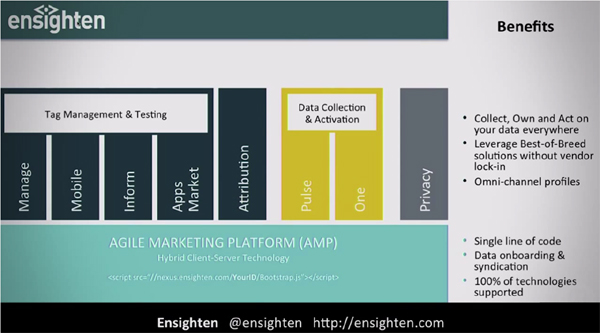
Adobe Tag Manager, that’s out there. Google Tag Manager, Tealium is another tag management solution.
Signal is another one, this is the one that we think it’s really rocking it in the United States. What’s cool is they’re not just a tag management system, they also have mobile tag management but they built a tool that allows you to recompile your mobile apps without actually having to take it to the app store.
If you have a big app and you want to change some content, or you want to change the functionality of some of the app, you can do it through app libraries, instead of actually recompiling it and hoping that people re-download it from the app store which doesn’t happen a whole lot.
They also built what I think is one of the coolest things in marketing technology right now – their Inforum Solution. Actually, it’s marketing technology analytics so they can see which one of your technologies and your marketing tags are working, which ones are not, how slow they’re firing, or how fast they’re firing. Are they pulling your data, are they collecting the data from that, so Inforum stuff is pretty sweet.
Then their activation allows you to collect all of that data and then they send it through their data layer. They have a data layer that they send that through, and they partnered with LiveRamp to create those user profiles and send all that information through. Definitely, something you want to check out if you’re trying to build out a tag management tool.
Know your elements – this is cool. This is Ghostery. These are the top 100 tools or tags for different marketing technologies that are deployed across the top Fortune 500 websites. It’s pretty interesting to see that.

Ghostery are tracking about 2,000 of these marketing technologies right now. Say for example, here’s Home Depot and here’s a really good way to do competitive analysis.

If you’re a bank in Australia – maybe you’re Westpac, or maybe you’re NAB, and you want to see what the other companies are doing, and you come here, and you get Ghostery which is a free plugin installed, you go “Oh, they’re using Adify, and Test & Target, they’re using BrightCo, Channel Intelligence, Crazy Egg, Criteo, which is a sponsor. All right? It’s great. Datalogics, they’re using Ensighten, Google Analytics, LivePerson, LiveRamp.
It’s really cool. Maybe you go to your competitor’s site, see what tools they’re using, you go “What’s Lijit? I don’t have any idea what the hell that is. Let’s go demo and check it out.” You want to make sure that your competitors aren’t getting an edge up on you with something cool, you don’t even know exists, so go check them out. See what’s working for them.
ObservePoint, if you do switch over to a tag management tool, you have all these tags on all these hundred thousand pages you’ve got to clean up, this automates that process for you a little bit. It tell’s you where all those are so you can clean them up quicker. Cool tool.
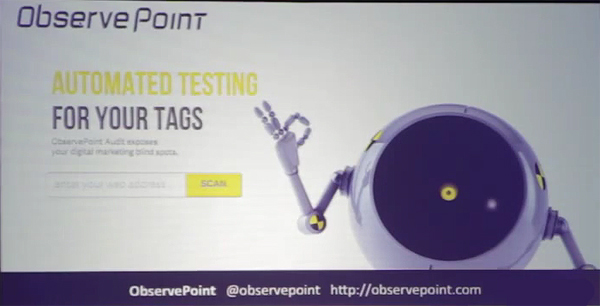
Another cool tool for marketers is nerdydata.com. You could take a snip of the code, or a keyword, or something, plug it in to this database, and it will tell you all the websites that that’s located on. You can find a back link and send that up there and see all the sites that all these are located on. That’s really cool. That’s a free engine right there, NerdyData.
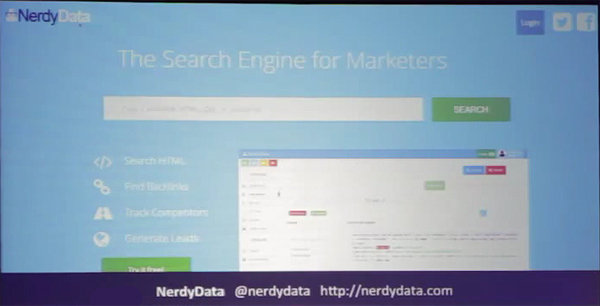
Zapier, anybody here played with Zapier? One? Two? This is awesome. A lot of times all these marketing technologies don’t speak with one another, Zapier actually has these different connectors that connect to all these different technologies so that you can plug information and pull information in.
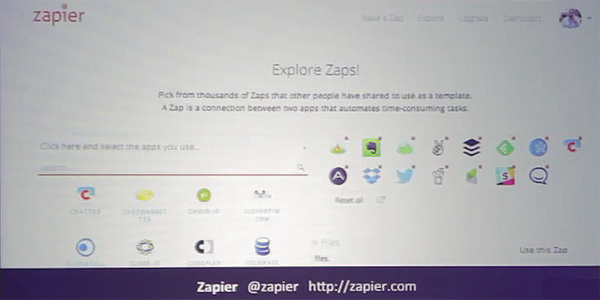
It’s basically like building a custom API for all your cool tools and then you can have them speak to one another and you can pull data from one place to another. Really cool. Again, this is probably why you need to have a coder on your marketing team to help do some of this stuff. It’s really sweet, so, if I upload this on Dropbox, maybe it will send a note over to Evernote, or if I tweet this or this thing gets tweeted, then we need to send the message on HipChat to our team. Literally, hundreds of thousands of these different recipes you could do. It’s all based on which tools your team is using. Great stuff.
Import.io, this is for people who are not coders. If there’s some data on a website that you want to scrape, import.io is another free tool. You basically download their browser and you can go through and it will actually scrape data for you and put it in an Excel document or upload it in a format for your database. You can create your own crawlers which is really cool with this. That’s what I did. I created my own crawler with this tool, it’s not hard. I went to a lyrics website and downloaded, actually, scraped every single Beatles song ever.

All the lyrics from all the songs that the Beatles wrote and then we did a word frequency analysis on it to see which words were used most frequently. Then we built a custom word cloud creator. This is what I did, I ended up building this right here off the Beatles, based off the words that the Beatles used most often in their songs. I was really quite proud of myself. It’s pretty awesome.
I did add John Lennon in, the Beatles, and some words that were not there, but the number one word in all the Beatles songs is “I,” just so you know, and “you,” and “she,” and “so,” and “love.” That’s the Beatles.

A couple of social media tools
If you are an enterprise business or even an SMB business, all of your employees are on social media. You want to find a way to round them up and have them tweet out and share your messages because traditionally, people will trust employees of a company more than they will trust the company’s social media channel. If you can round that up and then orchestrate that, that’s huge. It’s gamification of your social team. That’s huge. There are some really cool tools to increase employee advocacy.
BuzzSumo is my favourite tool right now. It’s a content data tool. What BuzzSumo is, it has access to the whole entire Internet. If I want to type in a keyword, I can say for example, ‘marketing technology’, it will then show me over the last day, week, month, six months or a year which articles were shared the most across social media. Then I can find some really great content to curate that I might want to share on social media.
Also, for every one of those articles, you can click on it and it will show who shared that article. Then you can sort that information by their follower account or their cloud score. Crazy, right? Or you could say, ‘inc.com’, which was the most shared article in the part week on Inc or whatever website you want to go to. It will pull that information back for you, sort-able and exportable into an Excel document. It’s brilliant. I love it. I use that everyday. Pretty cool stuff.
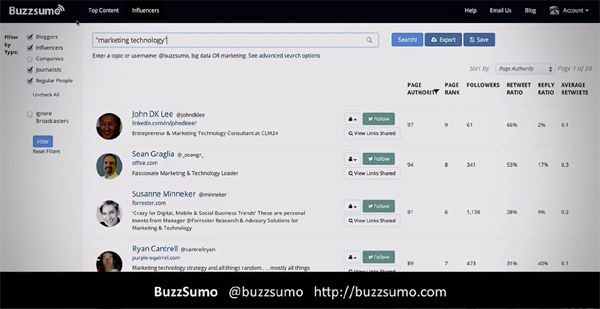
I actually use this, I was able to scrape articles from that, like which was the most shared article on Reddit or which was the most used words on marketing technology, analytics, marketing, big data. I was able to pull all those words, do word frequency analysis on that to see which words are used most often on different websites.
I did that on Inc and I said, “Which words are used most frequently in the most shared articles on Inc?” I was able to find that information and then I leveraged that, and I’ve twice had the most shared article on Inc with one article that I’ve written, because I use this data to sort of help me with my content creation, which is crazy.
Reddit, these are the most used words on Reddit. Here’s the most used words on LinkedIn, “job,” “work,” “best,” “interview,” “business,” “career.” Pretty obvious on that site there though. Cool.
Another site that is really awesome is TrackMaven. TrackMaven is like marketing voodoo to me. What it can do is it can track your competitor’s every single social thing that they’re doing on Twitter, Facebook, Pinterest, Instagram, all of them. It can give you a report on how they’re doing, what they’re doing. Not only that, it also shows your earned media and also the traffic, and SEO, your email marketing, your display ads. It pulls all of that in and gives you competitive intelligence, which is huge. You can literally track a company’s campaign from start to finish through TrackMaven. Crazy.
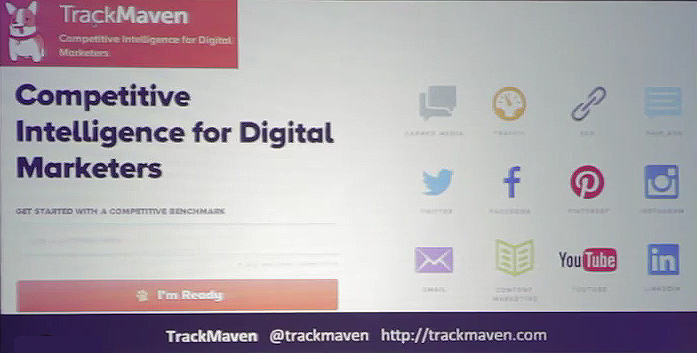
Rival IQ, this is a quick tool. You can literally just plug in your competitors and it will shoot you out a hundred-page PDF, or a PowerPoint presentation with all these analytics about what they’re doing. That’s interesting.
Socedo – if anybody here is doing social media selling or trying to connect with really awesome people on social media, specifically on Twitter, this is another tool that I use multiple times a week. What you do is you put in conversational words and you type in the words you want to listen for, which words do you want people to be talking about. Then you also have words that are located in their bio like “I want to have VP, or marketing, or CEO, or CMO” on their bio, and then what it’ll do is it will turn out and find all these people for me everyday.

What happens is you go “Oh, I like that person. Approve.” Then what happens is it will favourite their tweet and then an hour later, it follows them, then another hour later, it puts them in a list. Then if they follow you back, it sends them a direct message and if they follow you back, you can send them a LinkedIn request. If they kick back to you on LinkedIn, you can send them an automated LinkedIn message back to them, “Thanks for connecting. So great to connect with you, first name.”
You can literally do seven different automated engagements before you’ve even talked to the person and they’re messaging you back. It’s crazy. You got to be really careful with it because whenever I use this, I typically end up getting like a hundred direct messages back to me like “Travis, it’s so nice talking to you” like “Wow, I have so many emails. I have so many messages I have to respond to now.” It’s crazy, but the tool is phenomenal.
Another one – Little Bird. This is basically an influencer tool, so you can see who’s most influential on any topic. Say for example, marketing in Seattle, I want to find the most influential people that live in Seattle around marketing. Then what it does is, it says, “Well, here’s 500 people that I found that are influential about marketing in Seattle” then it ranks them by who’s followed the most by other people who are influential about marketing in Seattle. It’s not just who says they’re influential, it’s how many of these people follow each other and which ones are the most influential. Really cool tool.
Data.com, love this. This is actually how I got to write for cmo.com. I typed in “CMO,” found the editor-in-chief of cmo.com and said, “Hey, here’s some stuff I’ve written. I would like to refer you” and then he emailed me back and said, “Okay,” so I did.
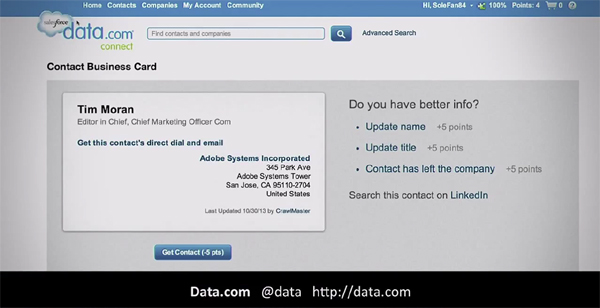
The periodic table of content marketing

This is really cool, just different words that all apply to content marketing, it’s pretty awesome. Coolness. Good stuff.
Again, here are some more resources for you to jot down.
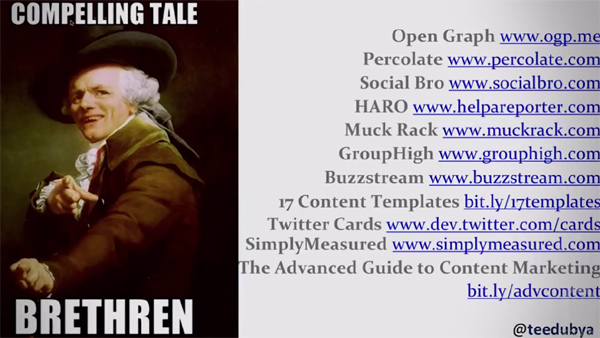
I literally have 250 white papers and definitive guides to different things, pertaining to marketing, conversion, optimisation, landing page stuff, all the different things upon data and stuff.
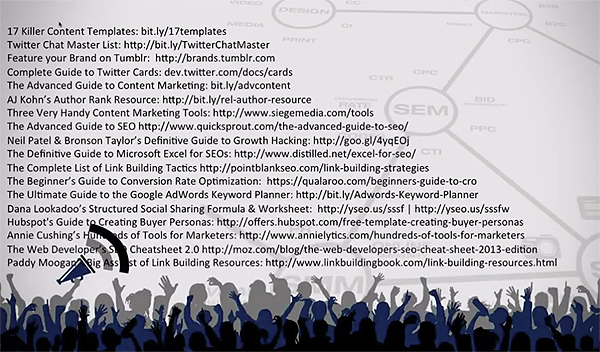
There we go, this is mind-blowing! ccpglobal.com/datasym and…The End!
You can view the entire presentation below.
Join the sharpest minds in the industry at Customer 360 to learn how to Reach, Engage and Delight your most profitable customers. Learn from inspiring international keynote presentations and local case studies. Topics covered include Omni-Channel Customer Experience, Content Marketing, Social CRM, Customer Analytics, Customer Strategy, Multi-channel retail, Loyalty Marketing, Net Promoter Score, Contact Centre Management and Social Media Analytics.
The Customer 360 Symposium will be held in the Hunter Valley from March 30 to April 1. Find out more about it here.
About Gavin Stewart - Marketing Director, Ashton Media
Gavin Stewart is the Marketing Director and co-founder of Ashton Media, leaders in the creation, production and marketing of highly targeted, invitation-only, executive conferences. Gavin is an expert B2B marketer with over 13 years experience delivering event audiences. Specialties include: audience development, marketing strategy, email marketing, DM, SEO, SEM, analytics, social media, creative and sales.

